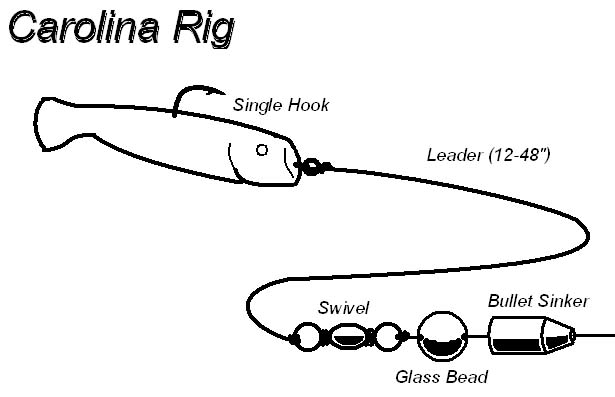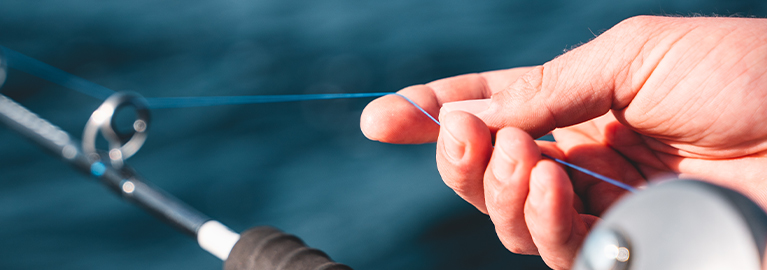As a new angler, setting up a fishing line for saltwater fishing is one of the most significant challenges you will face. All those little inventions, knots, tools, and piles of stuff in your shovel ball box can be confusing.The good news is that learning how to set up a saltwater fishing line can be difficult. Once you understand what the rigging is, what the parts do, and the different types of configurations, it’s much less stressful.
4 step to set up your fishing line for saltwater
Step 1: Slide the sinker or slug weight onto the line and slide the bead. The bead and sinker work together to create a little resonance in the water.
Step 2: Slide the end of the cord through the swivel joint. A semi-hanging or modified knotting method is good.
Step 3: Cut a line 15-24 inches long. Tie the leader to the faucet
Step 4: Tie the hook, lure or jig to the end of the leader.
If you want to know more details, please read this article.Let’s get started so you can start fishing!
Inshore or Offshore
Now that you have these provisions in place, you need to know what kind of place you will be fishing in order to prepare the right type of saltwater fishing line.
Offshore fishing usually requires heavier equipment and larger bait, while inshore fishing can be done with lighter tackle and a variety of live and dead baits that are easy to use and obtain.
So you won’t be confused, inshore fishing is defined as fishing at least 9 miles from the shoreline. In such places, the ocean can be very deep, so it is sometimes referred to as deep sea fishing.
Different Types of Saltwater Rigs

For the sake of simplicity, and since this topic will soon be a book, we will focus on four types of saltwater rigs. These include:
Surf Fishing – One or two, sometimes three hooks, a weight and a connector. The goal is to create a situation where the hook and bait or lure dance in the current as the waves ebb and flow. You can set the weight of the rigging above or below the hook.
Fishing with bait-Carolina rigs are usually the rigs we use when fishing with bait or jigs.
Bottom fishing- Usually a two hook rig with a sinker on the bottom.
Dock fishing – Usually a Carolina rig or floating rig, depending on what you are targeting.
When and where you fish, water conditions and depth often dictate what kind of rig you choose. Below, we offer a four-step plan for creating the perfect saltwater trolling line rig.
Gearing Up
If you’re just getting into fishing, there’s no reason to spend too much money on all the top-of-the-line gear. In fact, you can do the job with a high quality, low cost starter without dumping your money.
Reels – A good 4000 size reel will work well for those just starting out. There are many brands to choose from, but it’s a good idea to check to see if it’s suitable for saltwater fishing.
Line-A 20-pound braid will provide a good balance between ease of use and durability. You can catch most of your fish with this type of line. Try to buy from a reputable brand, as there are many generic fishing lines on the market that have questionable origins and performance.
Rods – You can choose a medium to medium weight power rod that matches the reel and line you choose. There is no need for a top-notch setup, just check for good quality and you’re all set.
4 Steps to the Perfect Saltwater Fishing Line Setup
The rig is one of the most versatile pieces of brine equipment and it is very easy to learn.
What you need:
Off-field hooker – size depends on your target.
A slug weight
A bead
A Rotation
Step 1: Slide the sinker or slug weight onto the line and slide the bead. The bead and sinker work together to create a little resonance in the water. Fish have a side line that allows them to feel the vibrations in the water. When the sinker slides down and hits the bead, it creates a resonance that the fish can feel. The lateral line on the fish is one of the ways they find food. The beads, which can be plastic or glass beads, prevent your knot from being damaged by the edge of the sinker. In the Carolina setup, the stretch card ball slides freely up and down the sideline.
Step 2: Slide the end of the cord through the swivel joint. A semi-hanging or modified knotting method is good.
Note: So far, you have only used the end of the line on the spool. In step 3, we add a leader.
Step 3: Cut a line 15-24 inches long. You can use shorter leading yards when the water is calmer and you will use longer leading yards when there is more movement in the water. If you are fishing offshore in weedy areas, short leader yards may be best. If you are fishing in deeper water, then a longer leader is best. Adjust the length of the leader to suit the fishing situation. Leads can be a yard long, but are usually shorter than two feet.Then tie the leader to the faucet.
Step 4: Tie the hook, lure or jig to the end of the leader. Improved knot tying is good, but you can also check out our article on saltwater knot tying.
If you use a lure and drop the line, all that’s left is to hook the hook with the lure. One tip: If you are spot welding, a shorter leader is more accurate.
What Makes a Saltwater Fishing Line Different
A lot of new anglers think that fishing line is all the same, but that can’t be farther from the truth.
The difference between freshwater and saltwater fishing line will often affect how effective your lures are at attracting fish. Saltwater lines are made with a very stiff core.
Why? This is so that it can still function in the hot tropical conditions of the oceans. The diameters of saltwater lines are also smaller due to the fact that saltwater density allows for it, without affecting its floating capacity.
One additional benefit of this smaller diameter is that the line is easier to cast in windy conditions, that you will often encounter when saltwater fishing.
Lures and Baits for Saltwater
There are many options for the type and size of bait used in saltwater fishing. Much depends on whether you are fishing for a specific species of fish, but it can also be influenced by angler preference.
Some great beginner lures are a top water lure that twitches and moves back and forth across the surface, a mid-water lure that lets the water sink a bit and flies over and over when you pull it in, a flexible jig head lure that you can simply reel back in and looks natural when you pull it in, and a classic shrimp lure.
For lure selection, the live shrimp is a good performing classic lure that is easy to find at most lure stores.
Conclusion about Set Up Your Fishing Line For Saltwater
Saltwater fishing is both fun and exciting. It is very easy to get into and you only need basic equipment to get started. With practice, your skills will develop and you will soon be catching more and more fish.
FAQ about Set Up Your Fishing Line For Saltwater
Q: What type of fishing line is best for saltwater fishing?
A: The most commonly recommended fishing lines for saltwater fishing are braided lines or fluorocarbon lines due to their durability and resistance to saltwater corrosion.
Q: How do I choose the right pound test for my fishing line?
A: The pound test refers to the line’s strength or breaking point. It’s important to consider the size of the fish you’re targeting and the conditions you’ll be fishing in. Generally, for saltwater fishing, a pound test between 10-20 pounds is a good starting point.
Q: Should I use monofilament, fluorocarbon, or braided line for saltwater fishing?
A: Each type of line has its advantages. Monofilament lines are budget-friendly and have good knot strength. Fluorocarbon lines are nearly invisible underwater, making them suitable for finicky fish. Braided lines are incredibly strong and offer high sensitivity. Consider your specific fishing needs to make the right choice.
Q: What is the best knot to use when tying the fishing line to the hook or lure?
A: The improved clinch knot or the Palomar knot are commonly recommended for attaching the fishing line to hooks or lures. These knots provide strong connections and are relatively easy to tie.
Q: Do I need to use a leader when fishing in saltwater, and how long should it be?
A: Using a leader is highly recommended in saltwater fishing as it provides added strength and protects against abrasive elements. The length of the leader can vary depending on the fishing conditions, but a general rule of thumb is to use a leader that is 2-4 feet long.
Q: Can I use the same fishing line for different types of saltwater fishing (surf fishing, pier fishing, boat fishing)?
A: Yes, you can use the same fishing line for different types of saltwater fishing. However, it’s essential to adjust the pound test and consider the specific demands of each fishing environment to ensure optimal performance.
Q: How often should I change my fishing line when fishing in saltwater?
A: It’s recommended to change your fishing line at least once a year or more frequently if you notice any signs of wear, such as fraying, weakening, or excessive exposure to saltwater.
Q: Is it necessary to use backing when spooling my reel with fishing line?
A: Using backing, such as monofilament or dacron line, is necessary when spooling your reel with fishing line, especially if you’re using braided line. Backing helps fill up the spool and prevents slippage.
Q: What are some tips for preventing line twists and tangles in saltwater fishing?
A: To prevent line twists and tangles, make sure to spool the line onto the reel evenly, avoid overfilling the spool, use a swivel when necessary, and maintain proper casting and reeling techniques.
Q: Are there any specific maintenance steps I should take to care for my fishing line in saltwater conditions?
A: Rinse your fishing line with freshwater after each saltwater fishing trip to remove salt and debris. Inspect the line for any signs of damage, and store it in a cool, dry place away from direct sunlight to prolong its lifespan.

